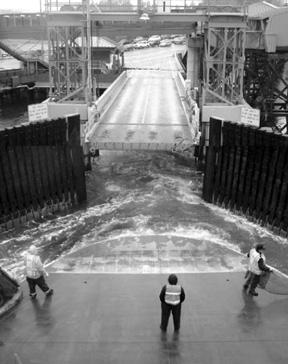Smith and Simpson answer with a vision for island’s artistic presence.
Creating a plan for The Street has been something of a road trip for artists Maggie Smith and Buster Simpson.
The two artists were commissioned by the city a year ago to conceptually frame, highlight and enhance three important points of entry to the island and downtown.
The result: an Arts Master Plan for Winslow Way, which was accepted by the council Dec. 10.
But calling the document a “plan” may be something of a misnomer, if the implication is a blueprint for specific objects.
“The thing with public art is that it’s pretty hard to make a fixed master plan,” Smith said. “Often public art has to jump at opportunities that arise out of construction projects. They have to be ready to jump.
“The purpose of this plan is to give public art a contour (that artists) can work with later.”
The two artists became involved in the project in the fall of 2002, when Smith, an island sculptor, noted a “call for artists” by the Bainbridge Island Arts and Humanities Council’s Public Art Committee.
Helping develop a vision for public art in Winslow sounded interesting – but Smith was busy designing and installing her public art projects on both coasts.
“I wasn’t thinking about participating,” she said. “I was too busy.”
But Simpson – an artist with a national reputation for public art whose work is on permanent display at IslandWood – wanted to apply, and talked his friend into pursuing the chance.
Although the project marked their first formal collaboration, Smith says, the commission seemed an extension of the shop talk both enjoyed.
“I like the way he thinks about work,” she said. “Everything he’s doing, he’s really thinking about the environment, particularly the flow of water. But he’s so non-didactic; he’s wonderfully inventive, so funny.
“I thought it would be great to involve him on the island, so I got into this because I wanted Buster to do something.
“I’m glad I did because I know a lot more about Bainbridge now – especially Winslow.”
Rather than begin by reading Bainbridge history or poring over maps, the pair chose to walk island
streets, looking for the particularities of place that form the philosophical underpinnings from which design decisions should emanate.
“We asked, ‘what is an island community,’ looking for the core values,” Simpson said.
Smith and Simpson identified “resourcefulness,” “sustainability,” “scale,” “intimacy” and “self-reliance” as keys to island identity.
They identified several major “gateways” to the island that could later be enhanced with art, signs and other amenities: The transition from water to land at Eagle Harbor and the ferry terminal; the intersection of SR-305 and Winslow Way; the passage through the UnoCal and Winslow Marine properties and the Winslow ravine; the turn west off the ferry onto Winslow Way that marks the entrance to downtown; and the Agate Passage bridge.
The pair met periodically with both the Downtown Winslow Gateway Advisory Committee and the BIAHC Public Art Committee.
“That was a great way to get into it,” Smith said. “We had the structure of these periodic meetings, for which we’d have to come up with ideas. And we had the group to bounce them off of.”
Over time, the artists progressed from considering
such overarching concepts as the gateways to smaller applications, from tree-planting projects to art that the pair dubbed “ephemeral and interventionist.”
“We went from the official grand entrances to encouraging quirky, homegrown things,” Smith said.
For Simpson, the paradox of the island – both surrounded by water and potentially threatened with a shortage of the resource – dovetailed with his ongoing concern for water treatments.
One of Simpson’s current projects in Seattle nurtures plantings along Vine Street with water collected in cisterns from adjacent building roofs.
On Bainbridge, Simpson suggested “bioswales” – channels planted with water-filtering plants – rather than storm drains to handle run-off.
Both artists feel that one indispensable element of any plan is the preservation and encouragement of a rich variety in visual design.
“The thing we argue against, especially on Winslow Way, is a kind of homogenization,” Smith said. “Because the really great thing about Winslow Way is that it’s a visual living history. It’s an accretion of layers. You build on that.”



